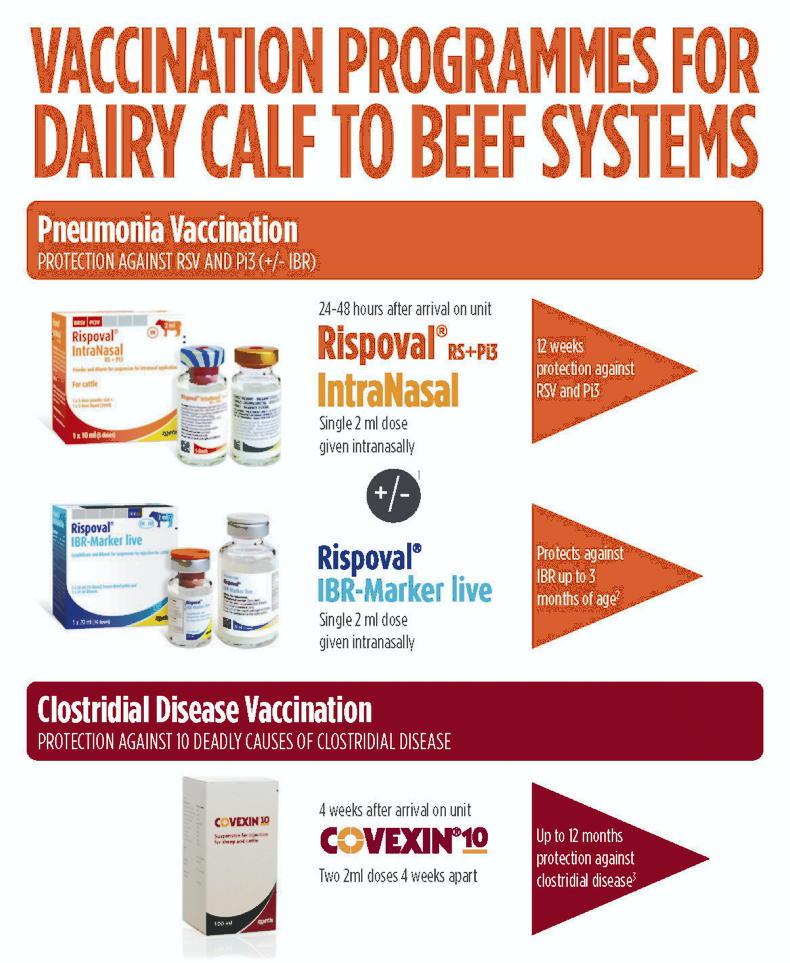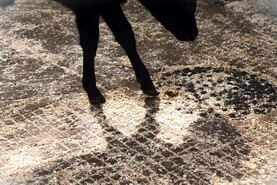One of the main issues with rearing dairy-bred calves in beef systems is that generally the calves come from several different dairy farms and are then mixed.
There isn’t a lot of social distancing, face masks or hand washing going on here, so as a result respiratory disease/pneumonia is common!
It is neither economical nor sustainable to be using antibiotics to prevent disease. What is required is a herd health plan that that includes a vaccination plan alongside correct management.
1. Nutrition: correct feeding of a good quality calf milk replacer and creep ration
Calf milk replacers (CMR) are the mainstay of many calf rearing enterprises. Both skim and whey-based milk powders can provide good quality feed but check the ingredients and nutrients they contain as they do vary. Dilution rates vary from product to product and are usually in the range of 125-150 grams of powder in 1l. The amount of calf milk replacer fed will depend on calf bodyweight, desired growth rate, environmental temperature and nutritional composition. It is important that fresh water is always available and fed separately from milk to promote rumen development and dry feed intake.
Starter feed should be available, and calves should have access to long fibre, preferably straw from a rack and not the bedding.
2. Calf shed: well ventilated, draught free, dry, warm, clean and cleanable
Incorrect housing provision can result in poor welfare and can predispose to disease outbreaks.
The essential factors in terms of housing are¹:
• Fresh air
The viability of bugs is negatively affected by clean fresh air. A virus will die in 5 to 6 minutes when there is 100% fresh air outside; if there is only 50% fresh air in a building it will take 60 minutes for the virus to die².
Air outlets in calf accommodation should be provided through, for example, an open ridge with upstands, and it may be that fans are required to provide fresh air (such as a 28-inch procter fan and perforated duct). The ballpark area of the outlet required for calves is 0.04m² per calf. The area of inlets should be at least twice or ideally four times that of the outlet.
• Control of airspeed
Whilst it is essential that fresh air is available in a building, all possible steps must be taken to avoid any draughts. A draught will increase stress levels and can lead to depressed immunity, leaving the calf more susceptible to disease.
• Moisture management
Maintenance of gutters and downpipes, mending leaking water troughs and ensuring urine drains away from the bedding will reduce overall moisture levels.
• Temperature
Temperature should be monitored by locating a min/max thermometer in the calf house. Calf jackets made from breathable material, 250W infrared bulbs for individual pens or 1500W linear heaters above group pens can be used to keep calves warm and have been shown to improve health and performance.
• Hygiene
The weakest point in many calf facilities are the many thousands of tiny cracks that, even after cleaning, provide a resilient home for bugs outside the host. Apart from the many tiny fissures in pens and walls, the joints between the walls and the floor are a predictable source of re-infection. This could easily be improved upon by for instance rendering and painting the walls to above animal height. By improving cleanability of pens, the time and money invested in the cleaning process is more likely to pay back.
3. Bug control: correct vaccines, at the right time
There is no silver bullet and all the above need must be carefully managed.
Vaccines must be correctly stored before use and given to calves that are not stressed or under pressure. When calves are stressed, their cortisol levels are high and they are ready for fight or flight, not combatting disease or producing an immune response to vaccination. Therefore, calves should not be vaccinated the moment they arrive on the farm or when they are being disbudded or castrated.
Ideally, farmers should wait for 24 to 48 hours after calves have arrived and then vaccinate them with an intranasal vaccine against RSV, Pi3 and IBR. These are known to be the most common causes of viral pneumonia on Irish farms ³.
Calves can be vaccinated against RSV and Pi3 from nine days of age with Rispoval® RS Pi3 IntraNasal which will protect them for 12 weeks. Rispoval® IBR-Marker live can be given intranasally in calves from 14 days of age to protect them against IBR for up to three months of age.
Calves should not be disbudded or castrated until at least two weeks after intranasal vaccination.
Clostridial diseases are common and generally affect calves once they go to grass. However, they require 2 injections of the vaccine under the skin before they are protected. Ideally the first injection is given 2 weeks after the calves have been disbudded and the second one shortly before going to grass. Aetiological agents most commonly detected in cattle include Clostridium novyi, Cl. chauvoei, Cl. sordellii, Cl. perfringens and Cl. Septicum.3 Covexin® 10 which protects cattle from 10 deadly causes of clostridial disease provides cost-effective protection.
The price to pay for clostridial and respiratory disease is high, so apply the good old mantras of "don’t wait, vaccinate" and "prevention is better than cure" and benefit from a reduction in the number of losses in the future.

1 No information is available on the safety and efficacy of concurrent use of Rispoval RS + Pi3 IntraNasal with Rispoval IBR-Marker live. The decision regarding timing of administration of either vaccine in relation to the other should be made by the prescribing veterinary surgeon on a case by case basis.
2 In young calves with Maternally Derived Antibodies (MDA) to BHV-1 protection afforded by the vaccine may not be complete until revaccination at 3 months of age.
3 The presence of MDA may reduce the antibody response to vaccination in young calves.
References
1Jamie Robertson (Livestock management systems Ltd) presentation Young Vet Network (2016) at Corries farm, Northern Ireland
2J. E. Benbough and A. M. Hood, Viricidal activity of open air, J. Hyg., Camb. (1971), 69, 619
3All-Island Animal Disease Surveillance Report (2018)
Rispoval® RS+PI3 IntraNasal contains modified live Bovine PI3 virus and BRSV. Legal Category: POM (E). Rispoval® IBR-Marker live contains Bovine Herpes Virus type 1 (BHV-1), strain Difivac (gE-negative), modified live (attenuated) virus. Legal Category: POM (E). Covexin® 10 Suspension for injection for sheep and cattle contains C. perfringens type A toxoid, C. perfringens type B & C (ß) toxoid, C. perfringens type D (e) toxoid, C. chauvoei whole culture, C. novyi toxoid, C. septicum toxoid, C. tetani toxoid, C. sordellii toxoid, C. haemolyticum toxoid. Legal category: LM. For further information please contact your veterinary surgeon or Zoetis, 2nd Floor, Building 10, Cherrywood Business Park, Loughlinstown, Co. Dublin D18 T3Y1. (01) 2569800 or www.zoetis.ie. Use medicines responsibly (www.apha.ie). ZT21/02/1






 This is a subscriber-only article
This is a subscriber-only article





